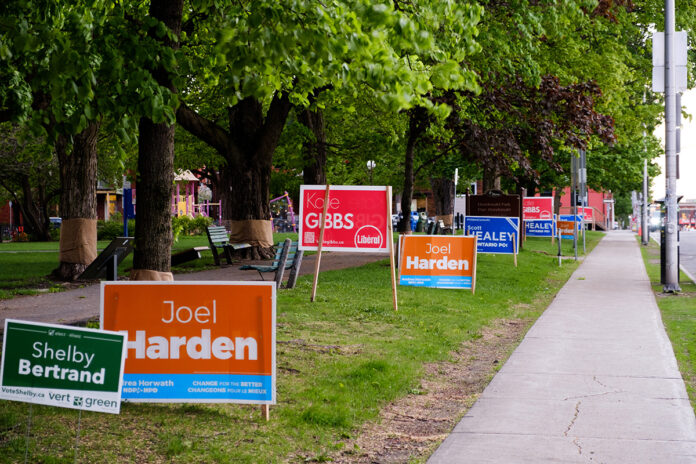
As voters get ready to head to the polls June 2, students may be wondering how they can get involved in Ontario’s first pandemic-era provincial election.
“Elections Ontario is committed to removing barriers to voting for all electors,” Elections Ontario media relations clerk Ebru Ozdemir Erol said in an email to the Charlatan.
“If an election is called during a school year, Elections Ontario works with campus organizations to ensure students know how, when, and where they can vote,” he said.
He said Elections Ontario visited more than 50 campuses across Ontario in March to inform students about the election and encourage them to register as voters.
Digital copies of voting brochures, accessible voting handouts and student elector guides were sent to every post-secondary administration in Ontario on April 8, he added.
“Students in Ontario who are living away from home can choose whether they wish to vote in the electoral district for their permanent, or home address, or the electoral district for their address while at school,” he said.
Erol directed students who want to vote in their home riding to apply to vote by mail. Students studying outside Ontario are eligible for the absentee voter register if they have not lived outside the province for more than two years.
Those absent during the election must apply by 6 p.m. EST on May 27 to receive a mailed ballot. Only ballots received by Elections Ontario before 6 p.m. EST on election day will be counted.
Only students living in residence can vote on campus. Students living off campus must vote at their assigned voting location.
“Carleton University supports student civic engagement and encourages students to take part and vote in all elections, including the upcoming Ontario provincial election.”
Voting in person will require either a voter card and ID that shows the voter’s name or one piece of ID containing both their name and address. Valid pieces of ID include a driver’s licence, phone bill, student card, transcript and report card.
Those voting by mail must show either government-issued proof of their name and address or one government-issued proof of their name and another kind of proof for their name and address.
Working voters are entitled to three consecutive hours off of work for voting, free of penalty and pay deduction. Voters also have from 10 a.m. to 8 p.m. EST on all 10 days of advance voting to cast their ballot, though poll stations may be moved within ridings.
“Carleton University supports student civic engagement and encourages students to take part and vote in all elections, including the upcoming Ontario provincial election,” Steven Reid, Carleton University’s media relations officer, said in an email to the Charlatan.
Anyone wishing to donate to an election campaign, including by cryptocurrency, may contribute up to $3,325 this calendar year. Cash and anonymous contributions cannot exceed $25 and contributors and their amounts are disclosed for donations exceeding $200.
Students wishing to get involved in the election can work as information assistants and tabulator deputy returning officers if they’re 16 or older, and as election officials if 18 or older. All positions are paid, include training and incorporate ePoll books, vote tabulators and other tools.
Student engagement
Elections in Ontario have historically experienced low voter turnout among all demographics.
Christopher Waddell, professor emeritus at Carleton University’s School of Journalism and Communication, said this could be because students may be unsure “which level of government is responsible for the things that affect them.”
Waddell said provincial responsibility for things like health care, education, social service and urban transportation may, in some cases, affect people’s day-to-day lives more significantly than federal services do.
“Students might just tune out and say, ‘Well, it doesn’t involve me, I don’t see myself in the policy, why should I go and vote?’”
Velma Morgan, chair of Operation Black Vote Canada, said parties have rarely mentioned students so far this election and have said little about plans to address issues that most affect youth.
“Students might just tune out and say, ‘Well, it doesn’t involve me, I don’t see myself in the policy, why should I go and vote?’” Morgan said.
Waddell said students may be specifically interested in employment opportunities and concerned about challenges for international students, who can’t vote but are a “revenue raiser” for schools.
“There hasn’t been much evidence that they’ve been talking about any issues that would concern students, either financial issues or, on the other end, the nature of post-secondary education,” Waddell said.
“Which should be a big concern, because there’s an awful lot of people at the post-secondary level, and also the institutions are really important in the communities they’re in,” he continued.
Morgan said the election happening in June, a time when many students do not attend school, could also affect youth voter turnout. Being at home could mean they don’t have the information they need to vote, she said.
“It’s going to be more difficult to get post-secondary students [to the polls] because they’re spread out all over the place, rather than on campus,” Waddell said.
Morgan added Elections Ontario has a role to play in increasing student engagement as well, noting the abundance of election jobs it could market to students.
“I think that’s an opportunity for Elections Ontario … to ensure that youth are participating and they understand how the process works from the back end by getting them to come and work on elections in the various roles that are available.”
Another factor that might attract students is the new Elections Ontario app, which gives voters an electronic ID for poll stations and information about candidates and poll locations in their riding.
Lydia Miljan, acting director of the University of Windsor’s Humanities Research Group, said in an email to the Charlatan that Elections Ontario “heavily” advertising its new app may help engage more youth voters.
As Morgan put it, “the lasting impact of any policy that’s created” will be on the province’s youth.
Students can add or modify their voter information or find their poll locations at elections.on.ca.
Featured image by Arno Ryser.





